Prune the sprawling Argentine giant cactus
Prune Argentine giant cactus
Here in the southwestern desert at Desert Life Design, we use graphic design, photography, and creative writing to create a compelling call-to-action.
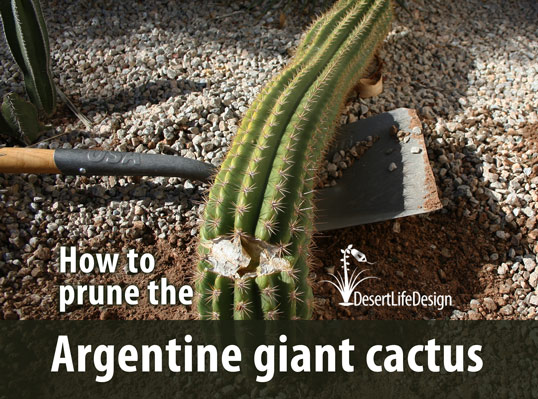
How to prune the sprawling Argentine giant cactus
by Doug M. at Desert Life Design
The Argentine giant cactus (Echinopsis candicans or the earlier classification of Trichocereus candicans ) is a easy-to-grow xeriscape plant with show-stopping white flowers. As it grows, it makes lots of pups around its base that you can safely remove and transplant for a whole new colony.
Long sprawling arms means more flowers
In addition, this cactus does sprawl along the ground as the arms or columns get longer. In a way, the sprawling growth is good, because as the arms grow, they produce more spectacular flowers.
Argentine giant cactus does not get very tall
Usually, this so-called giant cactus stays on the small side—its arms usually only get two or three feet tall. As the arms continue to grow in height and add weight, they naturally lean over and eventually sprawl along the ground.
I don't like when my Argentine giant cactus sprawls
Once, I even had a three-foot high column tip over during the summer. Its column slowly bent over until there was a 90-degree, rounded angle near the base of its column (see photo below).
The side that was outside the angle split open as the column continued to grow along the ground. To me, it looked really unattractive.
Because of the intense summer heat where I live, I let it continue to grow along the ground. Then, when the autumn finally arrived and the temperatures moderated, I decided to fix my sprawling giant cactus.
The solution is to prune the cactus
Luckily, gardeners can take advantage of this plant's sprawling nature and use it to create more Argentine giant cactus colonies. Pruning your cactus can improve its health, make it look better in your landscape, and be a source of new plants.
Required tools:
- Gardening or pruning gloves
- Pruning saw
- Shovel
- Strands of twine or rope
In addition to those tools, I also used a pick to break up my clay-based, caliche soil. Looser soil makes it easier for the sprawling, transplanted cactus arm to shoot out new roots from its base.
You might also want to add soil amendments like sand, perlite or pumice to enhance drainage.
1. Wrap twine around column
Use the twine to help support the cactus arm as you move it to a new location. It's best to wrap the twine around the arm before you cut.
By using at least two strands of twine or rope, you can more easily support the heavy column of cactus during the process.
2. Cut the column on an angle
Use your saw to cut the column off from the base of the plant. In my case, I cut right where the column had split and formed a callous (see photo below).
In addition, I cut the column on an angle. That way, rain will run off more easily and will be less likely to cause rot.

3. Dig hole to transplant new arm
Dig a hole at least twice the width of your column. In my case, I used a pick to loosen up the soil so the new roots can easily extend from the base.
In addition, dig the hole deep enough to provide support for the arm. This cactus has arms that can be very heavy, so a deep hole will help provide support until it develops an adequate root system.
While I did not amend my soil, I did make sure the new location drained well. As an insurance policy, it might be wise to mix in some garden mulch specially formulated for succulents, or perlite and pumice.
4. Place column upright in new hole
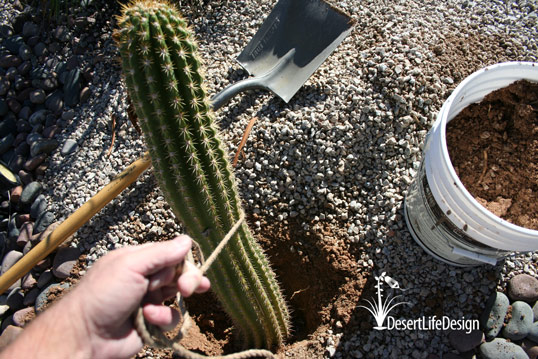
Use the twine that you wrapped around the cactus arm to safely carry it to its new home.
Position the column in the hole. Use the twine to help support it in an upright position while you back-fill with soil and amendments.
Use your foot or shovel to fill in the hole and compact the soil around the base.
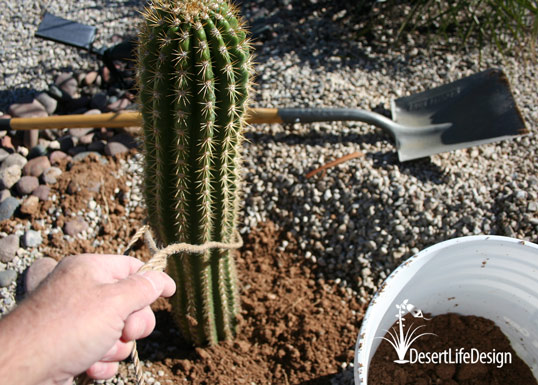
Generally, it's always good practice to allow any cactus cuttings enough time to form a callous. The hard callous can help prevent rot while your new cutting develops its own roots.
However, I almost always plant my cactus cuttings immediately. In my experience, the new cuttings develop roots more quickly, while also forming a protective callous while in the new soil.
To prevent rot from developing in new cuttings, always be sure the soil drains well and is dry when you plant.
Over time, new pups will grow around the main column
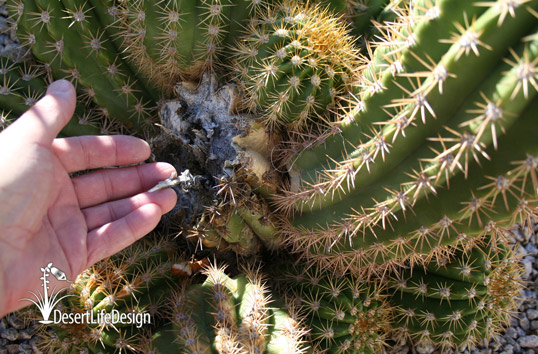
Throughout the following year, new pups will grow around your transplanted base. In a few years, you will have an attractive new community of Argentine giant cactus, and it all came from that sprawling cactus arm that you transplanted!
Provide some afternoon shade
The Argentine giant cactus seems to do best when it receives some afternoon shade, especially during the scorching southwestern summers. I found an ideal location near a corner of my xeriscape. There, it will be a perfect companion to two San Pedro plants along with a large century agave, even while it gets its afternoon shade.
Enjoy the beautiful flowers
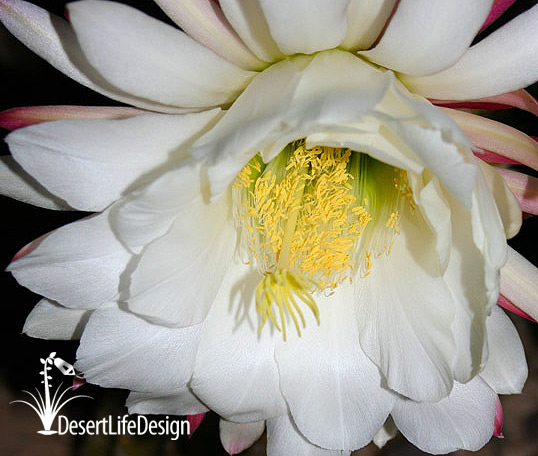
After the pruning and transplanting is finished, you can sit back and enjoy as your Argentine giant cactus grows. It will produce spectacular flowers that will be the envy of your neighbors.
Heck, you might even give your neighbor cuttings of your pups so they can enjoy this beautiful cactus in their own landscape.
Writing and photographs from Doug M. at Desert Life Design! If you'd like to read more about xeriscaping your landscape, please click here.

Desert Life Design™ is based in the Phoenix, Arizona metro area. Here, we strive for perfection in graphic design and concise written communications.
